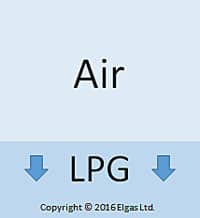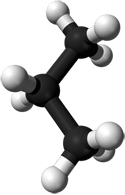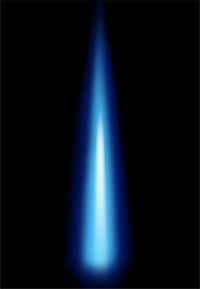LPG Gas vs Natural Gas and Natural Gas vs LPG or Propane Gas vs LPG
Considering LPG vs natural gas, the main difference between natural gas vs LPG (propane) are the constituent gases and how they are supplied.
Methane gas and natural gas are the same thing, distributed by gas mains or pipelines.
Liquefied petroleum gas (LPG) is propane or butane, usually distributed as LPG in gas bottles.
Other significant differences between liquefied petroleum gas (LPG) or liquid petroleum gas vs natural gas are they have different energy content, gas/air mixes for combustion and working pressure.
LPG Gas vs Natural Gas Commonalities
LPG gas vs natural gas are both hydrocarbon gases. Both liquid petroleum gas and natural gas are sourced from oil and gas wells.
Both liquid petroleum gas and natural gas are produced through natural gas and oil refining or processing.
The most common uses of liquid petroleum gas and natural gas are as fuel gases for domestic heating, hot water and cooking as well as for industrial processes involving heat.
Both liquid petroleum gas and natural gas are also feedstock for petrochemicals.
Define LPG – Meaning of LPG Gas – Definition of LPG – GPL Gas
The definition of LPG (propane) or meaning of LPG gas is liquefied petroleum gas (LPG), a flammable compressed hydrocarbon fuel gas consisting of propane, butane and isobutane.
Liquefied petroleum gas (LPG) is typically stored and shipped as LPG in gas bottles or LPG in gas tanks
In other countries, LPG gas is know as GPL gas, due to differences in language and syntax.
LPG Gas vs Natural Gas Differences: Summary of LPG Gas and Natural Gas Key Differences
- Liquefied petroleum gas (LPG) is propane and/or butane while natural gas and methane gas are the same
 Liquefied petroleum gas – LPG (propane) is heavier than air while natural gas is lighter than air
Liquefied petroleum gas – LPG (propane) is heavier than air while natural gas is lighter than air- LPG in gas bottles is liquefied through pressurisation.
- Natural gas is cryogenically turned into liquefied natural gas – LNG
- Liquefied petroleum gas LPG (propane) is distributed as LPG in gas bottles, cylinders, and tanks
- Natural gas is conveyed via pipeline
- Liquefied petroleum gas LPG (propane) appliances operate at 2.75 kPa
- Natural gas appliances operate at 1.1 kPa
- Liquefied petroleum gas LPG (propane) turns from liquid to gas at a relatively low temperature
- Liquefied petroleum gas (LPG) : Propane is C3H8 & Butane is C4H10 whilst the Natural Gas and Methane formula is CH4
- Liquefied petroleum gas LPG (propane) has a higher energy content at 93.2MJ/m3 vs natural gas at 38.7MJ/m3
- Liquefied petroleum gas LPG (propane) requires a higher air to gas ratio for combustion at a 25 to 1 ratio vs natural gas 10 to 1 ratio for natural gas
- Liquefied petroleum gas LPG (propane) is derived from natural gas processing.
- Liquefied petroleum gas LPG (propane) is distributed as LPG in gas bottles and tanks vs natural gas being conveyed via pipeline
- Although there are major differences between the two, liquid petroleum gas and natural gas are used for thousands of applications in homes and businesses.
Is Liquified Petroleum Gas the Same as Propane? Liquified Petroleum Gas vs Propane
Liquefied petroleum gas LPG (propane) is the same as propane. Propane is one of the gases considered to be LPG (propane).
However, there are also other gases that are considered to be liquefied petroleum gas LPG (propane) including butane, isobutane, ethane, ethene, propene, isobutene, butadiene, pentane, and pentene and pentanes plus.
So, in a phrase I coined many years ago: “Propane is LPG but not all LPG is Propane”.
LPG vs LNG vs CNG – What is the Difference?
The question of LPG vs natural gas includes LNG – Liquefied Natural Gas and CNG – Compressed Natural Gas.
- LNG (Liquefied Natural Gas) is natural gas (methane) in cryogenic storage.
- Liquefied petroleum gas (LPG) is mainly propane in liquid form under pressure.
- LNG is cryogenically turned into liquefied natural gas.
- CNG (Compressed Natural Gas) is natural gas stored at high pressure.
- Liquid petroleum gas and natural gas are different chemicals with different formulae
Both CNG and liquefied petroleum gas LPG (propane) come in gas cylinders.
Comparing natural gas vs LPG in gas bottles, natural gas cylinders are much heavier.
Which is More Expensive Between LPG Gas and Natural Gas
In some liquid petroleum gas and natural gas cost situations, liquefied petroleum gas LPG (propane) can be cheaper than natural gas for the end users.
For starters, there are daily natural gas supply charges for being connected to the main gas network.
Costs can exceed $400 per year, in Australia, even before any gas is used.
Liquefied petroleum gas LPG (propane) has a higher energy content and the relative positions of LPG gas vs natural gas change over time, with liquefied petroleum gas LPG (propane) now a cost-effective alternative to natural gas in many cases.
The cost of using LPG vs natural gas and supply charges will depend on where you are located and how much gas you use.
Liquefied petroleum gas LPG (propane) contains more heat energy and burns slightly hotter than natural gas.
Liquefied petroleum gas LPG (propane) is a great option as an alternative fuel during the transition to renewable energy sources.
What are Natural Gas Liquids – NGL Meaning
NGL meaning is Natural Gas Liquids which are heavier gaseous hydrocarbons that are included in the raw liquified natural gas stream from the wellhead.
NGL hydrocarbon gases include propane, butane, isobutane, ethane, ethene, propene, isobutene, butadiene, pentane, and pentene and pentanes plus.
Pentanes Plus is a mixture of liquid hydrocarbons, mostly pentanes, and heavier elements.
Natural gasoline is the largest component of pentanes plus.
Raw natural gas also contains impurities including water vapour, hydrogen sulphide (H2S), carbon dioxide, helium, nitrogen, and other compounds that must be removed.
Propane, butane, and isobutane are the three gases that are typically sold as LPG in gas bottles or bulk.
Propane – What is Propane? Liquid Propane Gas
What is Propane? Propane is the liquefied petroleum gas LPG (propane) that is supplied to virtually all homes and most businesses that purchase LPG in Australia, remembering that propane is liquefied petroleum gas LPG (propane).
is the liquefied petroleum gas LPG (propane) that is supplied to virtually all homes and most businesses that purchase LPG in Australia, remembering that propane is liquefied petroleum gas LPG (propane).
Liquid propane gas is propane liquefied under pressure and stored as LPG in gas bottles.
You turn the propane – LPG to gas by releasing some of the pressure.
Liquefied petroleum gas LPG (propane) is supplied in 45kg gas cylinders that are either exchanged or refilled on-site by LPG tankers.
Liquefied petroleum gas LPG (propane) is also delivered in larger 90kg and 210kg cylinders for homes and businesses, and smaller 9kg and 4kg BBQ gas bottles that are available from dealers around the country.
Butane (n-Butane)
Butane (n-Butane) is another liquefied petroleum gas (LPG) that is supplied to certain businesses where butane has specific advantages over propane (LPG).
is another liquefied petroleum gas (LPG) that is supplied to certain businesses where butane has specific advantages over propane (LPG).
These include greenhouse applications and use as a propellant in aerosols.
Autogas (Propane/Butane mix)
Autogas is liquefied petroleum gas (LPG) sold at petrol stations can be either propane or a propane/butane mix.
Autogas is an economical and clean burning Liquefied petroleum gas (LPG) fuel that can extend your vehicle’s engine life while also reducing greenhouse gas emissions.
Get $100 in LPG Account Credits!
Choice of 2-Year Fixed or Variable 45kg Gas Bottle Price
No Lock-in Contracts
We return your old gas bottles for you
It is a great time to switch to ELGAS
Natural Gas and Liquefied Petroleum Gas (LPG) Energy Content (Methane vs Propane)
 The difference between liquid petroleum gas and natural gas energy content is easy to see.
The difference between liquid petroleum gas and natural gas energy content is easy to see.
Energy content of LPG vs natural gas (93.2MJ/m3 vs 38.7MJ/m3) has liquefied petroleum gas LPG (propane) with a higher energy content.
Liquefied petroleum gas LPG (propane) is more dense than natural gas, at a specific gravity of 1.5219:1 vs 0.5537:1, amongst other differences shown below.
|
LPG Gas and Natural Gas – Gas Properties
|
LPG
(Propane)
|
Natural Gas
(Methane)
|
|
Chemical Formula
|
C3H8
|
CH4
|
|
Energy Content: MJ/m3
|
93.2
|
38.7
|
|
Energy Content: Btu/ft3
|
2572
|
1011
|
|
Energy Content: MJ/kg
|
49.58
|
52.5
|
|
Boiling Temp: Cº
|
-42
|
-161.5
|
|
Flame Temp: Cº
|
1967
|
1950
|
|
Flame Temp: Fº
|
3573
|
3542
|
|
Gas Volume: m3/kg
|
0.540
|
1.499
|
|
Specific Gravity
|
1.5219
|
0.5537
|
|
Density @15ºC: kg/m3
|
1.899
|
0.668
|
Note: Some liquid petroleum gas and natural gas numbers have been rounded.
Relative Density: LPG Gas vs Natural Gas Density
 There is a difference between liquid petroleum gas and natural gas density.
There is a difference between liquid petroleum gas and natural gas density.
Liquefied petroleum gas LPG (propane) is more dense (has a higher specific gravity) than the relative density of natural gas.
Comparing LPG vs natural gas, liquefied petroleum gas LPG (propane) has a higher density.
Liquefied petroleum gas LPG (propane) is heavier than air, at the relative density of LPG at 1.5219 to 1.
The heavier relative density of liquefied petroleum gas LPG (propane) makes it settle in air.
Density of natural gas (methane) is lighter than air, as it is less dense (lighter) than air, with the relative density of natural gas being 0.5537 to 1.
The lighter relative density of natural gas makes it rise in air.
LPG Gas and Natural Gas Flame Temperature
When considering natural gas and and natural gas flame temperature, natural gas and and natural gas burn at virtually the same temperature, with liquefied petroleum gas LPG (propane) burning slightly hotter than natural gas.
Liquefied petroleum gas (LPG) – propane – burns at 1967ºC or 3573ºF.
Natural gas burns at 1950ºC or 3542ºF.
Natural Gas vs LPG Gas – Which is Better
Which is better comparing natural gas vs LPG superiority?
You can see how liquefied petroleum gas LPG (propane) is better than natural gas when you buy a cooktop.
Cooktops usually come with two sets of gas jets.
The ones for liquefied petroleum gas LPG (propane) have a much smaller hole and use less gas.
That’s because liquefied petroleum gas LPG (propane) contains more heat energy, with 93.2MJ/m³ vs natural gas at 38.7MJ/m³ (2572 Btu/ft³ vs 1011 Btu/ft³).
Liquefied petroleum gas – LPG in gas bottles has some distinct advantages, including portability and higher energy content.
It may also be cheaper than natural gas in many situations.
Natural gas has a safety advantage vs liquefied petroleum gas (LPG).
As natural gas is lighter than air, in the event of a leak, natural gas will dissipate more quickly.
As liquefied petroleum gas – LPG (propane) is heavier than air, it may collect in basements or near the floor of a home.
Natural gas has some other advantages, too.
It produces slightly less CO2 when burned, although both are low carbon emitters.
It also doesn’t need to be delivered, as it typically comes though pipes (gas mains).
So, as to if liquefied petroleum gas LPG (propane) is better than natural gas, it really comes down to a matter of opinion. Both natural gas and and natural gas have their advantages.
Is Propane Natural Gas – Is LPG Natural Gas
Liquefied petroleum gas LPG (propane) is not natural gas.
Liquefied petroleum gas LPG (propane) is better described as LPG in gas, as it is a raw natural gas derivative, produced during raw natural gas processing.
Likewise, propane is not natural gas.
Remember: “propane is LPG but not all LPG is propane”.
Natural gas is methane whilst liquefied petroleum gas (LPG) is propane or butane.
Natural Gas – Gas Processing – How is Natural Gas Made?
 Natural gas is a fossil fuel found deep underground in a natural gas rock formations.
Natural gas is a fossil fuel found deep underground in a natural gas rock formations.
The gas is recovered by drilling a natural gas well. It can be found alone or with crude oil.
The raw natural gas or ‘wet’ gas must be processed to separate out the natural gas liquids, like liquefied petroleum gas LPG (propane), as well as water and other impurities.
So, liquefied petroleum gas LPG (propane) is a natural gas co-product.
The dry natural gas is passed through the gas pipelines that deliver it to our homes and businesses.
What is Liquefied Petroleum Gas – LPG? What is LPG?
LPG is the acronym for Liquid Petroleum Gas, which is the correct spelling. It can also be spelled “Liquefied petroleum gas (LPG)”, which is actually the more commonly used term. “Liquid petroleum gas” is also seen.
Liquefied petroleum gas LPG (propane) is a liquid fuel stored in gas bottles and tanks.
Liquefied petroleum gas LPG (propane) is used for heating our homes, hot water, cooking, powering our BBQs, and fueling our cars, along with powering many business and agricultural enterprises.
LPG to Gas – How Does Liquefied Petroleum Gas – LPG work?
Liquefied petroleum gas LPG (propane) is stored under pressure in a liquid state as LPG in gas bottles.
 When using liquefied petroleum gas LPG (propane), you release it from the gas cylinder and it turns liquid LPG to gas.
When using liquefied petroleum gas LPG (propane), you release it from the gas cylinder and it turns liquid LPG to gas.
From a practical point of view, it is used just like natural gas, although the liquefied petroleum gas LPG (propane) energy content is much higher.
As it is portable, it can be used in vehicles as well as home heating, hot water and cooking.
To boil, turning liquid LPG to gas, it draws heat from the steel walls of the LPG gas cylinder (propane tank) which, in turn, works by getting heat from the ambient air. (See image)
LPG liquid boils and turns LPG to gas vapour when you release some of the pressure in the gas bottle (propane tank) by turning on your gas appliance.
As with water, the more heat that is applied, the more rapidly it boils, vaporising at a faster rate.
What is Liquefied Petroleum Gas – LPG Made Of?
 Liquefied petroleum gas LPG (propane) is a natural gas and crude oil derivative.
Liquefied petroleum gas LPG (propane) is a natural gas and crude oil derivative.
The gases that fall under the liquefied petroleum gas LPG (propane) label include propane, butane, and isobutane, as well as mixtures of these gases.
The two most common are propane and butane and the percentage of propane and butane in liquefied petroleum gas LPG (propane) varies.
Show Me My Offer
- Elgas to the Rescue with Helicopter LPG Delivery - November 14, 2024
- Gas Patio Heater Guide: Outdoor Gas Heaters – Outdoor Mushroom Heater - September 22, 2024
- LPG Meaning – LPG Means: What Does LPG Stand For - August 31, 2024
Steve Reynolds
Technical Consultant
Steve Reynolds is a leading expert in the LPG industry with over 22 years of experience. As part of the national management team at ELGAS, Steve ensures the safe and efficient storage, handling, and transportation of LPG. He serves as the lead investigator for incidents and collaborates with authorities on industry developments.
Steve is a technical advisor to Standards Australia and Gas Energy Australia (GEA), and an active member of the World LPG Association (WLPGA), contributing to global standards and technical reviews. He holds a BSc. (Hons) in Industrial Chemistry from UNSW and has held senior safety and technical roles at ELGAS, making him a trusted authority in LPG safety and standards.

